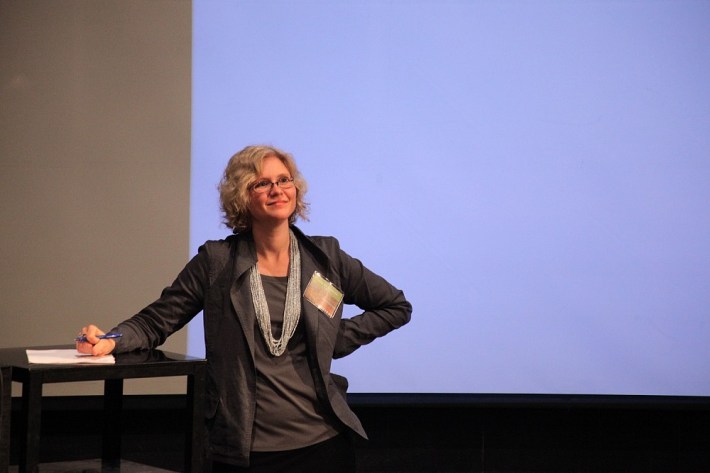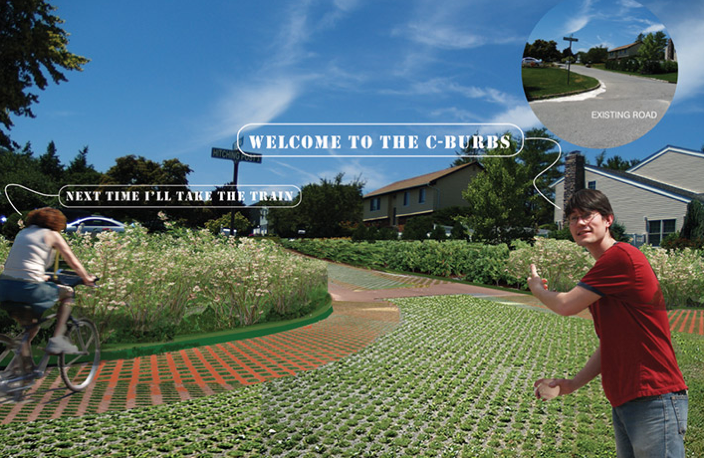The suburbs are changing. As cities grow in population and the poverty once associated with urban areas becomes more widely dispersed, even the meaning of "the suburbs" is evolving in the popular consciousness.

Architect June Williamson has studied suburban evolution and adaptation for more than a decade now. She was co-author, with Ellen Dunham-Jones, of "Retrofitting Suburbia." Her new book, "Designing Suburban Futures, New Models From Build a Better Burb," draws on her experience leading the "Build a Better Burb" design competition, which engaged top urban thinkers and designers in strategizing to revitalize greyfield spaces around Long Island.
We caught Williamson by phone recently to ask her what she learned about successful 21st century suburbs through the competition and the process of writing her new book.
Angie Schmitt: What are some of the factors that are compelling change right now in American suburbs?
June Williamson: The need to combat climate change and high carbon footprints that are more typical of suburbanites than urban or downtown dwellers. Increased acknowledgement of the eventual approach of peak oil conditions. The need to not only reduce demand for energy, but also find more renewable resources. A third might be the demographic change in suburbia that is happening because of longer lifespans and the aging of the baby boomers, which is leading to a decreased percentage of the population comprised of households with children. You have a large supply of detached houses and a shrinking supply of households with children to inhabit them. There’s also the proliferation of immigrant suburbs or ethnoburbs combined with the recent rise in suburban poverty.
And I think these are all things that are contributing to change happening, whether people desire it or not. And then there’s the aging of the physical fabric of, especially, the post-war suburbs. The areas that were all built out 50 or 60 years ago. And a lot of them, especially the commercial structures, were relatively cheaply built. They weren’t built to be durable. That is also creating conditions for change but also opportunities for physical transformation.
AS: What would be your advice for suburban communities that are attempting to adapt?

JW: There’s a chapter where I've synthesized and analyzed all sorts of examples to provide a range of new tactics. They range from very lot-scale tactics … from reinhabiting a dead big box store, turning it into a public library or something like that, to ideas for sort of thinking about communities working together with sort of bottom-up mechanisms to support community improvements like neighborhood wi-fi or putting a basketball court into a neighborhood. And then there are sort of downtown-scale tactics which could involve suburban agriculture, and how to implement that and network that, or using transit infrastructure to leverage opportunities to support infill [development] in downtowns. Or rethink the parking lots that tend to predominate there where buildings were torn down to service the needs of commuters who live in the more outlying subdivisions. Making more connected, walkable complete streets. And then there are the sort of regional scale tactics that might involve revising zoning codes to permit accessory dwelling units or to transform public works standards -- sort of rethinking how policy responds to stormwater systems or managing aquifer resources, or maybe thinking about carbon, those sorts of things.
AS: Can you offer specific successful examples? What were the major takeaways for you from this whole process?
JW: The successes are mostly ahead of us. We're working toward transformative change. One of the things that has come out in the past decades, as I have been researching and contributing to this research, is a shift in this kind of city-suburb oppositional thinking. Where cities were sort of dynamic places of change but also of danger and suburbs were somehow timeless and fixed, both in the cultural imagination and literally. I think that kind of oppositional thinking has really broken down. So that all of the sort of urban ill and pathologies that have been conventionally sort of ascribed to cities can be found in suburbs too. I think there’s more realization of that.
The suburbanization of poverty, there are sort of poor, distressed suburbs and still the wealthier, richer ones. There are a much more diverse set of conditions. And also the transportation thing is a piece of it, the aging thing. And then there’s desire: a sense that people are in the suburbs because they want that. That in many many cases, and Long Island is a case in point, where there aren’t a lot of other choices, frankly, that people can afford, or even that are available to them within commuting distance because of the suburbanization of workplaces, as well. So again, breaking down that notion that you live in the suburbs and you commute to the city. So that new geography is very exciting and offers a wealth of opportunity, but we’re still in the process, I think, of figuring out what to do with it and how to get there.
So there are lots of interesting case studies of dead shopping malls that have been retrofitted to make them more mixed-use and walkable town centers, and that’s terrifically exciting. But it would be a shame, I think, for people to think that we need to take all our shopping malls and turn them into mixed-use pedestrian centers. There’s much more strategic and interlinked and localized design work that has to happen, as well as civic discussions to figure out the various kinds of things that might happen in landscapes of under-performing asphalt.





